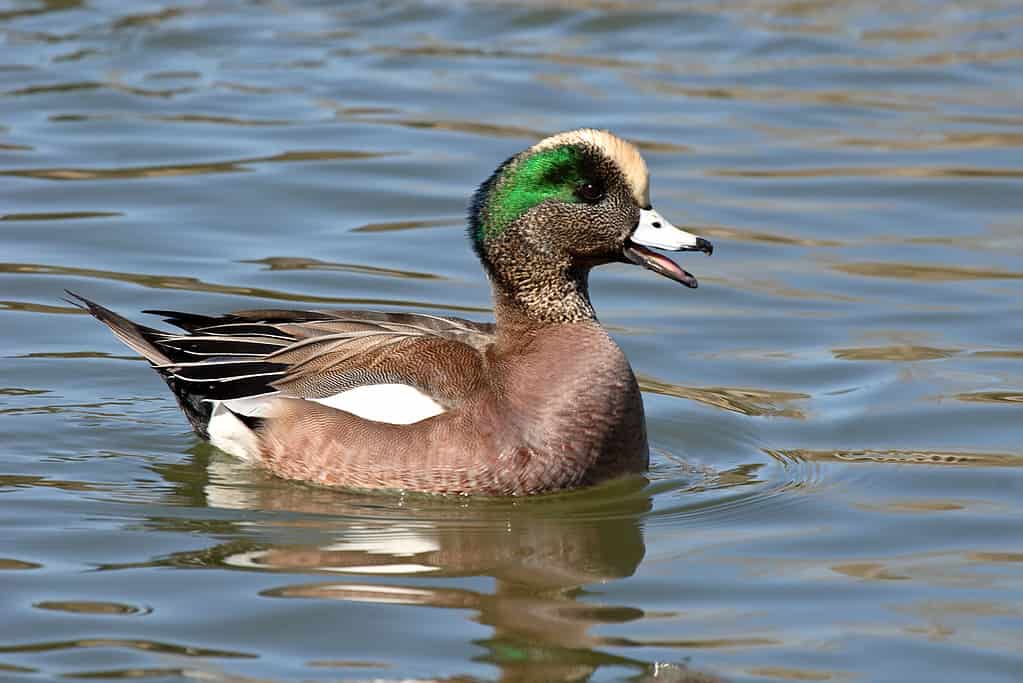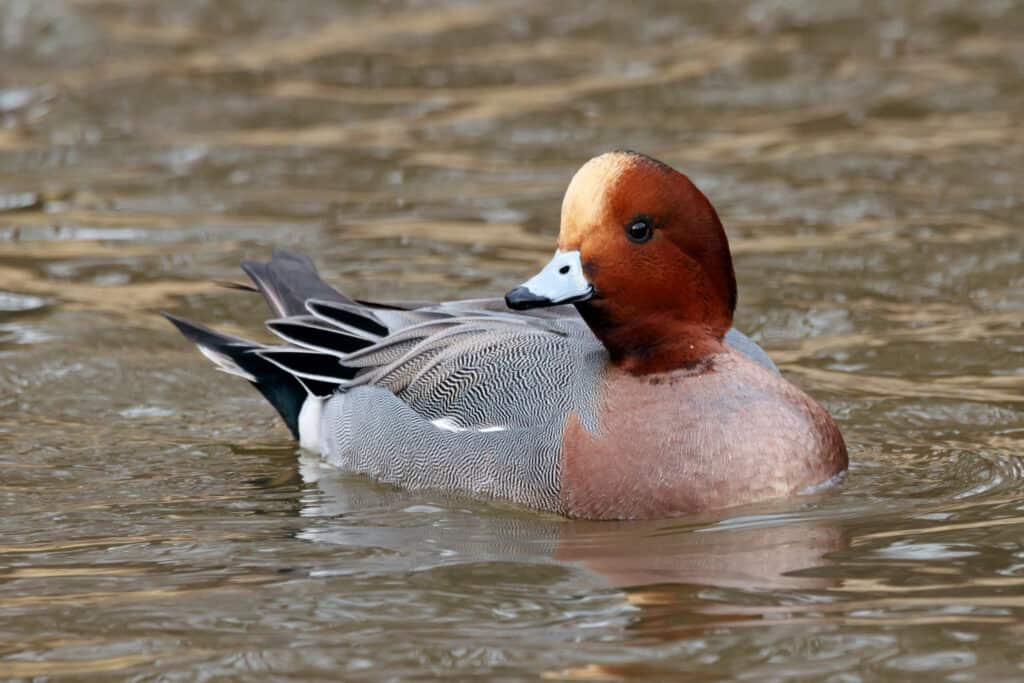Wigeons are one of the most iconic animals and are around most lakes and wetlands in North America. Wigoens are a type of duck species famous for their bright green eye feathers and white crown! If you enjoy spending time around lakes or wetland parks, there is a high chance that you have encountered or seen a flock of them swimming around. These birds are an iconic part of any trip to the lake, and there are so many fun facts about them to explore! With a load of different fun facts, different appearances, interesting migration patterns, and more, wigeons are super interesting! Keep reading below to learn more about some of the diets, symbolism, and habitats of these iconic birds!
Diet

Wigeons are both air, land, and aquatic birds!
©iStock.com/gatito33
A wigeon’s diet typically consists of plants, but they do consume insects as well! Being both land and aquatic animals, wigeons consume plants from both on land and in the water! One of the most popular foods for wigeons shares a name with the bird as well! Wigeon grass is one of the wigeon’s favorites to eat. Wigeon grass, known scientifically as Ruppia cirrhosa, is a bay grass that grows along bodies of water, hence why it’s common in wigeons diet. This grass offers lots of benefits to the bird nutritionally, but also plays a major part in the habitats for aquatic creatures such as small fish!
Other aquatic plants popular with wigeon are cattail, sedge, and duckweed. These are some of the most nutritional plants for the bird! Wigeons also eat land plants such as different seeds, wheat, rice, barley, and plain grass. These commonly found plants are essential to the health and well-being of the wigeon animal. Plants like rice that thrive in wetland environments are one of the reasons why wigeons have adapted to be both land and aquatic animals.
As mentioned, wigeons also eat insects from time to time. While not as common as eating plants, insects contain plenty of nutrients for wigeons and are often hidden within the plants they already consume. Some of the common insects are different species of flies such as horseflies, caddisflies, and damselflies. Other insects include beetles and mollusks, essential for the health of the birds. Female wigeons are the ones who mostly consume insects, especially during peak breeding season. This is because of the protein required to lay eggs and feed their young.
Symbolism
Wigeons and ducks in a more general sense have lots of symbolic interpretations! Being found on most continents, ducks are iconic in the myths and folklore of every society. One popular interpretation has to do with ducks’ connection with both air and water elements. Being both land and aquatic birds, ducks are seen as an animal that can bridge the gap between the elements. The ability to fly in the air represents spiritual liberation, the ability to float on water represents the conscious mind, the ability to dive in water represents the diving into emotions and thought, and the ability to traverse land represents skillful adaptation. These symbols have been used as a beacon of hope and a creature to learn from, inspiring humans for centuries!
Other forms of symbolism include definitions found in spirit animals! In the understanding of spirit animals, if a duck were to swim into your life, it is a representation of new opportunities and chances coming your way! There is an underlying message here as well. The goal of the duck is to help people move forward with their goals and ambitions, and to not hesitate when an opportunity shows itself to you! If you are ever lucky enough to be approached by a duck, take it as a sign to take a chance. You never know what you’ll get out of it!
Ducks are also a popular power animal. Power animals, similar to spirit animals, are messengers of specific traits that people can learn from. The duck’s traits are that of awareness and confidence. When observing ducks, they often are in groups together but tend to care for their personal space as well! Humans can learn from these traits greatly! Learning to go with the flow, but with your own pace can lead to happiness and confidence, ideal traits for a healthy mind and body! Learning to be confident in your relationships with others is a great trait to learn from ducks!
Habitat

Female wigeons have brown heads and grey feathers! This is compared to a green-headed male wigeon.
©Anton MirMar/Shutterstock.com
Wigeons are all across North America, and smaller populations live in the northern part of South America as well! Wigeons are migrating birds, so there are only a few places where the birds regularly inhabit. The upper west coast of the United States in Oregon and Washington are common places for these birds to frequently inhabit. The southern states are great places to rest for the birds, and breeding there is uncommon. Breeding will typically take place in the western half of Canada where they will later travel away from!
Wigeons typically migrate to the south for winter nesting, and this typically takes place in August and September. Flocks of wigeons are more fond of neutral temperatures, and staying up north in the summer and going down south in the winter is perfect for this balance! Wigeons prefer to nest in dense areas that give them plenty of cover and insulation to stay warm! For example, it is common to find wigeons under snowberry bushes in the winter. These bushes provide plenty of shelter for the birds to stay safe and content!
Wigeons are amazing for viewing, but it can be difficult at times! They startle very easily and will fly away from even the smallest noise, so be careful when trying to take pictures and a closer look. In forests and parks that permit hunting, wigeons have learned over time to avoid said areas! If you want to get a clear look at these amazing birds, try to go in the off-season and you’re sure to get an amazing sight!
Fun Facts
Wigeons are very interesting ducks and have plenty of interesting facts about them to learn about! One of the funnier ones is that wigeons will follow other migrating ducks and birds with the sole purpose of stealing said flocks’ food! These ducks are strategic in how they get their nutrients! The wigeon is also famous for being a full-diving duck! When hunting for food underwater, many ducks will only slightly submerge themselves in the water. Wigeons are hardcore, however, and can be often seen fully submerging themselves for the food they want! By fully submerging, these ducks are able to get more food than other ducks that only slightly submerge themselves.
Wigoens are also noisy ducks! When in large flocks, they can be heard from a good distance away by both quacking and flapping of wings. While this may mean they are a communicative species, this is also how they communicate danger with each other! By loudly quacking and flapping their wings against the water, other ducks in the area will understand that something is wrong and can quickly fly away!
Similar to other birds, male wigeons are often more colorful than females for the purpose of mating! Female wigeons are brown and grey in color all over, while males have a pop of color on their heads! On the head, these birds have green eye feathers that are almost metallic in appearance. The crown of their head is covered in white feathers, making them stick out within flocks! These birds are beautiful in appearance, and are perfect for bird viewing or watching!
Summary

The American wigeon’s scientific name is Mareca Americana.
©Gregory Johnston/Shutterstock.com
Wigeons are one of the most common aquatic birds in North America! With a population that spans from the northern part of Mexico and the Caribbeans to the north of Canada, these birds are often seen all around! These birds are most often found close to bodies of water such as lakes and wetlands and have lots of interesting facts about them! Your next time close to a body of water, look out for these wonderful birds!
Thank you for reading! Have some feedback for us? Contact the AZ Animals editorial team.








